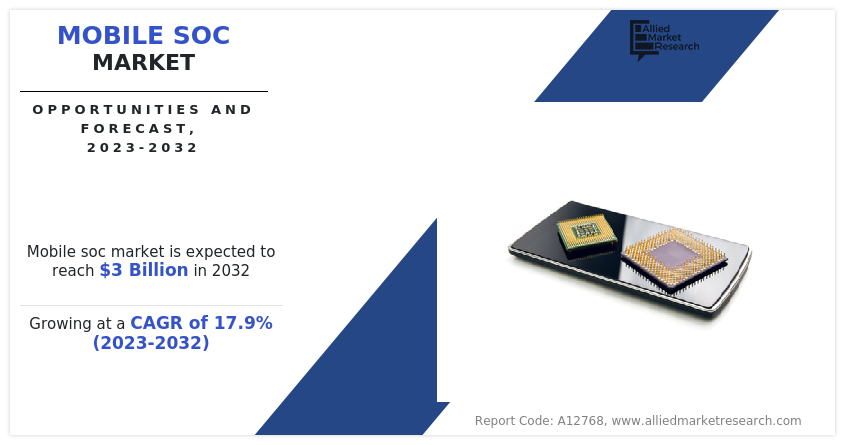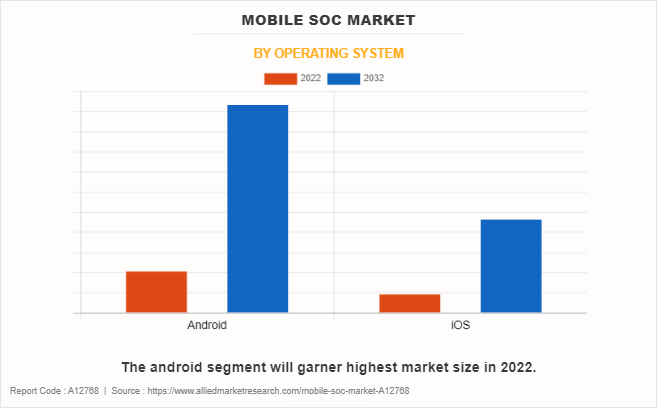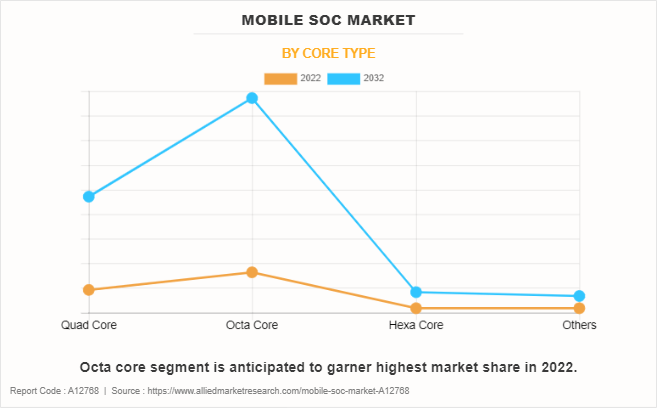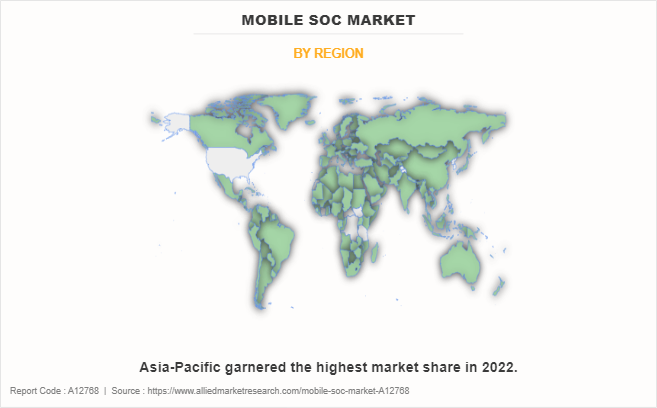Mobile SoC Market Research, 2032
The Global Mobile Soc Market was valued at $0.6 billion in 2022, and is projected to reach $3 billion by 2032, growing at a CAGR of 17.9% from 2023 to 2032.

A Mobile System-on-Chip (SoC) is a compact and integrated circuit that serves as the fundamental powerhouse within mobile devices, consolidating critical components onto a single chip. Comprising a central processing unit (CPU), graphics processing unit (GPU), memory, connectivity modules, and various hardware components, the primary objective of Mobile SoCs is to optimize performance, power efficiency, and overall functionality. The CPU acts as the device's brain, executing instructions and managing tasks, while the GPU enhances graphics-related functions, contributing to a superior visual and gaming experience.
Integrated RAM ensures quick access to data, vital for multitasking and smooth performance. Connectivity modules, such as Wi-Fi and cellular modems, facilitate seamless communication, and multimedia processing units handle tasks like camera and audio processing. Power management units optimize energy consumption, extending battery life.
Mobile SoCs find applications in smartphones, tablets, wearables, automotive systems, smart home devices, and industrial applications. End users, developers, enterprises, the automotive industry, and healthcare all benefit from the impact of Mobile SoCs, experiencing enhanced device performance, improved battery life, and access to a diverse range of applications and features that have become integral to modern life. The continuous evolution of Mobile SoC technology contributes to the advancement of mobile devices, making them more powerful, efficient, and versatile across various industries.
Segment Overview
The mobile SoC market is segmented into Operating System and Core Type.

On the basis of operating system, the market is divided into android and iOS. In 2022, the android segment dominated the market, and it is expected to acquire a major market share by 2032.

On the basis of core type, the market is divided into quad-core, octa core, hexa core, and others. In 2022, the octa core segment dominated the market, and it is expected to acquire a major market share by 2032.

On the basis of region, the Mobile SoC market trends are analyzed across North America (the U.S., Canada, and Mexico), Europe (the UK, Germany, France, and rest of Europe), Asia-Pacific (China, Japan, India, South Korea, and rest of Asia-Pacific), and LAMEA (Latin America, Middle East, and Africa).
Competitive Analysis
Competitive analysis and profiles of the major global mobile system on chip (SoC) market players that have been provided in the report include Advanced Micro Devices, Inc., Intel Corporation, Qualcomm Technologies, Inc., Apple Inc., Samsung, MediaTek Inc., HiSilicon (Huawei Technologies), NVIDIA Corporation, Unisoc (Shanghai) Technologies Co., Ltd., and NXP semiconductors. The key strategies adopted by the major players of the mobile SoC market is product launch.
Country Analysis
Country-wise, the U.S. acquired a prime share in the mobile SoC market size in the North American region and it is expected to grow at a significant CAGR during the forecast period of 2023-2032.
In Europe, Rest of Europe, dominated the mobile SoC market share, in terms of revenue, in 2022 and is expected to follow the same trend during the forecast period. France is expected to emerge as the fastest-growing country in Europe's mobile SoC market with a CAGR of 18.1%.
In Asia-Pacific, China, is expected to emerge as a significant market for the mobile SoC market growth, owing to a significant rise in investment by prime players due to increase in growth of consumer electronics in rural and urban regions.
In the LAMEA region, the Middle East garnered significant market share in 2022. The LAMEA mobile SoC market has witnessed an improvement, owing to the growth in inclination of prime vendors towards utilizing the mobile SoC across this region in smartphones, iPad and others. Moreover, the Middle East region is expected to grow at a high CAGR of 17.2% from 2023 to 2032.
Top Impacting Factors
The mobile SoC market is expected to witness notable growth in demand for mobile devices with enhanced capabilities and advanced features, and prioritize power efficiency for longer battery life. Moreover, increase in edge computing requires high-performance SoCs for AI inference, and growth in smartphone adoption in emerging markets offer untapped growth potential are expected to provide lucrative opportunities for the growth of the market during the forecast period. On the contrary, rise in competition among mobile manufacturers results in pricing pressure limit the growth of the mobile SoC industry.
Historical Data & Information
The global mobile SoC market is highly competitive, owing to the strong presence of existing vendors. Vendors of the mobile SoC market with extensive technical and financial resources are expected to gain a competitive advantage over their competitors because they can cater to market demands. The competitive environment in this mobile SoC industry is expected to worsen as technological innovations, product extensions, and different strategies adopted by key vendors increase.
Key Developments/ Strategies
- In January 2022, Qualcomm Technologies, Inc., the leading wireless tech innovator introduced the Snapdragon Ride Vision System, an Open and Scalable Platform for Automated Driving it is built on a four-nanometer (4nm) process technology system-on-chip (SoC) designed for an optimized implementation of front and surround cameras for advanced driver assistance systems (ADAS) and automated driving (AD).
- In April 2021, MediaTek Inc., a leading semiconductor company announced the launch of the flagship System on chip (SoC) named Dimensity 1200 processor, this chip featured high-performance processor technology, camera, AI features, gaming, and connectivity enhancements.
- In December 2021, MediaTek announced the launch of its Dimensity 9000 5G smartphone system on chip design for next-generation flagship smartphones, and announced device maker adoption and endorsements from some of the world’s biggest smartphone brands, including OPPO, vivo, Xiaomi and Honor. The first Dimensity 9000 powered flagship smartphones was launched in the first quarter of 2022.
- In September 2023, Apple announced the launch of its latest mobile SoC A17 Bionic mobile SOC which is anticipated to power iPhone 15 Series, which will focus on further refining mobile SoC market demand. According to Apple, the A17 Bionic mobile SoC will deliver top-notch performance in smartphone SoC market.
Key Benefits For Stakeholders
- This report provides a quantitative analysis of the market segments, current trends, estimations, and dynamics of the mobile soc market analysis from 2022 to 2032 to identify the prevailing mobile soc market opportunity.
- The market research is offered along with information related to key drivers, restraints, and opportunities.
- Porter's five forces analysis highlights the potency of buyers and suppliers to enable stakeholders make profit-oriented business decisions and strengthen their supplier-buyer network.
- In-depth analysis of the mobile soc market segmentation assists to determine the prevailing mobile SoC market forecast.
- Major countries in each region are mapped according to their revenue contribution to the global market.
- Market player positioning facilitates benchmarking and provides a clear understanding of the present position of the market players.
- The report includes the analysis of the regional as well as global mobile soc market trends, key players, market segments, application areas, and market growth strategies.
Mobile SoC Market Report Highlights
| Aspects | Details |
| Market Size By 2032 | USD 3 billion |
| Growth Rate | CAGR of 17.9% |
| Forecast period | 2022 - 2032 |
| Report Pages | 233 |
| By Operating System |
|
| By Core Type |
|
| By Region |
|
| Key Market Players | Apple Inc., NXP semiconductors, Samsung, HiSilicon (Huawei Technologies), NVIDIA Corporation, Unisoc (Shanghai) Technologies Co., Ltd., MediaTek Inc., Qualcomm Technologies, Inc. , Advanced Micro Devices, Inc., Intel Corporation |
Analyst Review
Mobile System on Chips (SoCs) have become integral components in smartphones, playing a crucial role in managing the diverse array of sensors embedded in these devices. This significance has witnessed a notable increase with the widespread adoption of 5G technology globally. The integration of sensors and 5G capabilities within SoCs enhances the overall functionality, connectivity, and user experience of modern smartphones.
In contemporary smartphones, an assortment of sensors contributes to features like location tracking, augmented reality, health monitoring, and various other applications that enhance user interactions. Mobile SoCs serve as the orchestrators, efficiently managing and processing data from these sensors. Key sensors include accelerometers, gyroscopes, magnetometers, ambient light sensors, proximity sensors, and increasingly sophisticated cameras with specialized image sensors.
With the innovation of 5G technology has ushered in a new era of connectivity, promising faster data speeds, lower latency, and greater network capacity. Mobile SoCs, designed to support 5G modems and communication protocols, play a pivotal role in harnessing the capabilities of this advanced network. The increased data transfer speeds and reduced latency facilitated by 5G empower sensors to deliver real-time data with unprecedented speed and reliability.
For instance, in the context of location tracking, 5G-enabled SoCs enhance the performance of GPS sensors, allowing for more accurate and responsive navigation. The integration of 5G also supports the development of immersive augmented reality (AR) experiences by providing a seamless and high-speed connection for sensor data, contributing to a more fluid and realistic AR environment.
Health monitoring applications benefit significantly from the synergy between mobile SoCs and 5G. Sensors that monitor heart rate, blood pressure, and other vital signs can transmit data in real-time over 5G networks, enabling timely and accurate health insights. This is particularly valuable in remote patient monitoring and telemedicine applications where instant and reliable data transmission is crucial.
In addition, the integration of sensors and SoCs equipped with 5G capabilities plays a crucial role in advancing smart cities and the Internet of Things (IoT). Sensors strategically placed in urban settings, serving purposes like regulating traffic, monitoring the environment, and ensuring public safety, can exploit the rapid data transfer speeds and minimal communication delay provided by 5G networks. This is made possible through the sophisticated communication features inherent in mobile SoCs
The upcoming trends in the Mobile SoC market include increased focus on AI integration, 5G connectivity, and energy efficiency for enhanced mobile device performance.
Smartphones is the leading application of Mobile SoC Market
Asia-Pacific is the largest regional market for Mobile SoC.
The global mobile SoC market was valued at $577.9 million in 2022.
Advanced Micro Devices, Inc., Intel Corporation, Qualcomm Technologies, Inc., Apple Inc., Samsung, MediaTek Inc., HiSilicon (Huawei Technologies), NVIDIA Corporation, Unisoc (Shanghai) Technologies Co., Ltd., and NXP semiconductors
Loading Table Of Content...
Loading Research Methodology...



